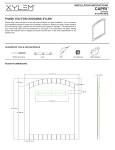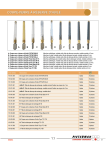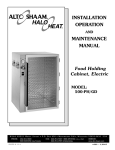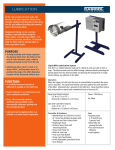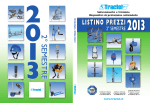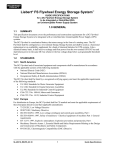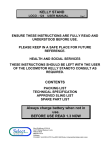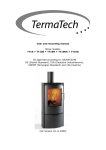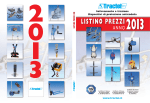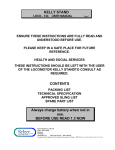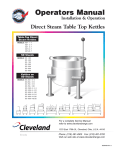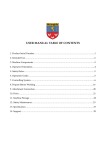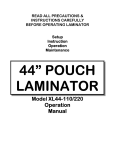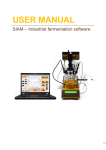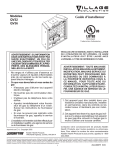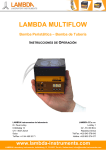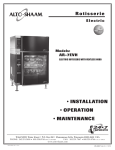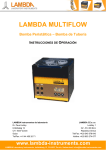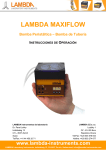Download Vacuum Lifter Safety Code
Transcript
Vacuum Lifter Safety Code Mark Mallen Health and Safety Manager Fenlock-Hansen Ltd March 2005 Vacuum Lifter Safety Code Version 1 Date: March 2005 Page 1 of 13 Contents Page 1 2 3 Aims Legal Framework Safety Code 3 4 5 Appendices 1 2 3 4 5 Hansen ‘Vacuum Lifter Pre-Use Inspection Check List’ How we create and loose vacuum Wind Speed Calculating Glass Weight Vacuum Lifter Capacity Vacuum Lifter Safety Code Version 1 Date: March 2005 8 10 11 12 13 Page 2 of 13 Aims We intend this guidance document to act as a reminder to trained vacuum lifter operators and serves as a useful source of reference material. Furthermore, untrained operators, acting under the control of trained operators, may use it, to ensure that operators follow their training. In addition, there is daily pre-use inspection sheet contained within, which operators must complete before using a vacuum lifter for the first lift and at the start of each subsequent day. Finally, legislation underpins everything we do. The opening section briefly describes some of the key pieces of legislation affecting the use of vacuum lifters. Our safety code is designed to ensure we comply with these key pieces. Vacuum Lifter Safety Code Version 1 Date: March 2005 Page 3 of 13 Legal Framework Health and Safety at Work, etc, Act 1974 Employees Section 7 Section 8 Employees must take all reasonable care to look after their own health and safety. Employees must not interfere with or damage any equipment or system put in place by their employers to safeguard their health and safety. Employers Section 2(2) Have a duty to: 1. 2. 3. Section 3 Provide safe plant and system of work Ensure safe use, handling, storage and transport of articles Provide information, instruction, training, and supervision to enable them to carry out their job safely. Have a duty to ensure that you carry out your undertaking in such a way as to ensure the health and safety of those not in your employ. Provision and Use of Work Equipment Regulation 1998 Regulation 9 Requires that all employees are provided with adequate training on all items of work equipment that they may use. Lifting Operations and Lifting Equipment Regulations 1998 Regulation 8 (1) Requires that employers ensure that all lifting operations are: 1. 2. 3. Properly planned by a competent person Appropriately supervised Carried out in a safe manner Regulation 9 (3)(a)(1) Requires that any lifting accessory used in conditions liable to cause deterioration likely to lead to dangerous conditions must have a thorough examination carried out by a competent person at least 6 monthly. Vacuum Lifter Safety Code Version 1 Date: March 2005 Page 4 of 13 Vacuum Lifter Safety Code Everybody 1) 2) 3) 4) 5) We assess each lift and record our findings in the document – Lift Management Plan, ‘The Plan’. It is the Lift Supervisor’s responsibility to ensure that everybody involved in the lift knows what to do and how to do it. If you have not seen ‘The Plan’, or had its contents explained to you, ask the lift supervisor to explain it to you. Ensure that you read the risk assessments and safe working practices in ‘The Plan’. If you do not understand them, ask questions until you are clear on what is happening and what we expect of you. Operator 6) 7) 8) 9) 10) 11) Ensure that you understand what you need to do before using the vacuum lifter. Check the operator’s manual; there may be features on the lifter with which you are unfamiliar. Check the documentation for the lifter, ensure that the certification is within date, do not use if the last test and inspection date is more than six months ago. If you are unfit or unwell, do not engage in any lifting activity, as your judgement may be affected. Do not forget the use of alcohol & drugs may impair your judgement, if you are under the influence of any substance, do not use the lifter. If using the lifter in conjunction with a crane, fixed or mobile, the operator must be a qualified slinger/signaller. Authorised Users 12) Vacuum lifters shall only be applied to the load and operated by : a) b) c) 13) Trained and authorised personnel, minimum age - 18 years of age. Maintenance personnel in direct performance of their duties Authorised inspectors (with trained operator in attendance) Where assistance is required from untrained personnel, a designated and trained person must be in direct supervision of the lift and lifter at all times. Personal Protective Equipment - PPE 14) 15) Wear the following PPE, as a minimum: Hard Hat Steel Toe Cap Boots Hi Visibility Jacket or Vest Gloves – Kevlar knit, with Nitrile rubber palms and fingers i.e. Powerflex Plus Safety Glasses In addition, the risk assessments and safe working practices for tasks you complete may specify additional PPE. For example, use harnesses and lanyards when working on hop-ups. Vacuum Lifter Safety Code Version 1 Date: March 2005 Page 5 of 13 Vacuum Lifter 16) 17) 18) 19) 20) Do not use a vacuum lifter tagged ‘Out of Service’. Check the vacuum lifter for any obvious defects i.e. damaged pads. Complete the ‘Hansen Pre-Use Inspection Check List’, before use, each day, see Appendix 1 If the lifter fails the pre-use check, label it ‘Out of Service’, do not use, and inform your supervisor. Ensure that all lifting appliances and attachments, for example: Minifor Lifting Block Shackles Lifting beam Strops Have a undergone a thorough examination within the last 6 months, accompanied by a certificate. Attach copy to the Lift Management Plan. Weather Conditions 21) 22) 23) Do not use the lifter in the rain or if the load is wet, see Appendix 2. Do not use the vacuum outside the operating temperature range of -1°C to 40°C. Do not use the lifter in wind speeds in excess of Beaufort Scale 3 = Wind speed 29Kmh. See Appendix 3. The Load 24) 25) 26) 27) 28) 29) 30) Never lift a damaged or faulty load. Never lift a wet load. See Appendix 2. Ensure the load is clean and dry before applying the pads. Dirt increases the risk of load slippage and moisture in the vacuum system lowers the amount of vacuum available over time. Ensure that the lifter/lifting device combination and any other accessories are capable of lifting the load. Check the delivery note and / or label on glass to determine its weight. If this information is unavailable, to calculate the weight of the glass, see Appendix 4. Do not forget the load is the weight of the glass, the lifter, and any other lifting accessories i.e. shackles or strops. Applying the Lifter 31) 32) 33) 34) 35) Always apply the lifter to within 40mm of the centre of gravity of the load. The load may be within the SWL for the lifter. However, ensure that the lifter is physically large enough for the size of glass. Refer to the supplier for technical assistance on pad spread. For guidance, see Appendix 5. Manufacturers recommend outer pad is no further than 500mm from edge of load. Clean and dry the pads correctly, before applying to the load. Any moisture in the vacuum system may reduce the amount of vacuum available over time. Lifting Operations 36) 37) Achieve the required vacuum and ensure that the pump turns off before attempting lift. Lift the load 50mm and wait for 30 seconds, before commencing lift, to ensure vacuum is stable. Vacuum Lifter Safety Code Version 1 Date: March 2005 Page 6 of 13 38) 39) 40) 41) 42) 43) The safe level of vacuum is 65%. Never lift from a rotated position. Never allow personnel to ride the load. Do not lift the load over people. Do not pull the load sideways. Never lift a load from flat position with the lift bar locked (see diagram). 44) If lifting between hop-ups, ensure personnel are available to watch and guide the load at each level. Observe the load at all times. If you spot problems, give the order to stop the lift, by shouting and by raising both arms aloft. Do not leave unattended suspended loads. 45) 46) 47) Releasing the Load 48) 49) 50) Fully support the load, before releasing vacuum. Never attempt to rotate off-centre loads as the frame could rotate too quickly. Never release catches simultaneously. Vacuum Lifter Safety Code Version 1 Date: March 2005 Page 7 of 13 Appendix 1 See Hansen ‘Vacuum Lifter Pre-Use Inspection Check List’ overleaf Vacuum Lifter Safety Code Version 1 Date: March 2005 Page 8 of 13 Vacuum Lifter Pre-Use Inspection Check List 1 2 3 4 5 6 Item 7 8 9 Manufacturer Model Serial Number SWL Last Examination Date Next Examination Date Description Yes✓ No✗ Check certificate, is thorough examination within date? If No, do not use. Is a user manual available for the operator? Is there any physical damage to the vacuum lifter i.e. cracked welds? If Yes, do not use. Are the vacuum pads for ripped or torn? If Yes, do not use. 10 Are the pads clean? If No, do not use and wash with warm soapy water. 11 Are the vacuum pipes and connections secure, pay particular attention to quick 12 release fittings? If No, do not use. Where fitted, are all individual pad shut-off valves open? If No, open valves. 13 Are electrical connections secure and all switches undamaged? If No, do not use. 14 Does input mains voltage correspond with charger voltage - 110v or 240v? If No, 15 do not use. Does battery have sufficient charge and is battery charger functional? If No, do 16 not use. Is the Safe Working Load (SWL) of the lifter, sufficient for the load? If No, do not 17 use. Are rotational and tilting movements functional? If No, do not use. 18 Energise vacuum lifter on Perspex or glass before commencing lifting duties. Are lights or buzzers on during vacuum application? If No, do not use. 19 Does vacuum reach sufficient level before pump switches off? If No, do not use. 20 Woods lifters - Does battery gauge illuminate when pump switches off? If No, do 21 not use. Pannkoke lifters - Does yellow pump (Pump) light remain illuminated? If No, 22 change 10a Fuse. Does vacuum drop 5% in ten-minute period? If No, do not use. 23 Where fitted, does remote vacuum application and release function correctly? If 24 No, do not use. Item Insert particulars of any defects and action taken Inspection conducted by Name Date Signature Vacuum Lifter Safety Code Version 1 Date: March 2005 Page 9 of 13 Appendix 2 How we create and loose vacuum What is a Vacuum? • A vacuum is a space completely empty of matter. • In practice, a vacuum exists whenever the pressure within a space is less than the pressure that surrounds it. How do we create a Vacuum? • We can create a vacuum by pumping out the air from within a vacuum chamber i.e. pad • As we remove air, fewer air molecules are present, to push against the vacuum chamber walls, thus reducing the pressure within the vacuum chamber. How do we loose a Vacuum? • If the pressure between the chamber and the atmosphere equalises How does a Vacuum Cup Work i.e. Pad? • As we remove the air from between the pad and surface, the difference in air pressure causes the cup to adhere tightly to the surface. • The pad adheres to the surface due to atmospheric pressure pushing against it. • Atmospheric pressure is approximately 14.7 pounds per square inch (psi), or over 1 ton per square foot, at sea level. • Therefore, as the surface area of the pad or pads, increases, the greater the weight acting against the surface of the object becomes. Causes of Vacuum Lifter failure • If the seal between the cup and the surface is broken, the vacuum fails and the load falls. • We preserve the seal by the maintenance of a vacuum between the pad and glass surface. • Conditions that affect the length of time that vacuum is maintained include: The cleanliness of the load surface and vacuum pad The roughness or smoothness of the load surface The porosity of the material lifted The condition of the vacuum pad, lines and pumps • In the case of power loss to the pump, vacuum lifters maintain a vacuum, which is stored in a vacuum reserve tank. • This reserve reduces significantly by the collection of condensate within the tank. • Condensate forms from moisture in the atmosphere, when we create the vacuum. • If we operate in wet conditions, or if the load is wet, we greatly increase the amount of condensate created. • However, on rough, porous, or heavily contaminated surfaces, where we cannot maintain a good seal during a power outage, immediate loss of the load may occur. Vacuum Lifter Safety Code Version 1 Date: March 2005 Page 10 of 13 Appendix 3 Wind Speed The maximum operating wind speed is 29 km/h, equivalent to 18mph, 16.5 knots or 8m/s. Use an anemometer to measure the wind speed. If one is not available, use the Beaufort scale, see below: Beaufort Scale: Devised by British admiral Francis Beaufort in 1805: Rating 0 1-3 4-5 6-7 8-9 10-11 Description Calm Light wind Moderate wind Strong wind Gale Storm Wind Speed @ 1.6 km/h up to 29 km/h up to 36 km/h up to 67 km/h up to 87 km/h up to 116 km/h Indicators Smoke rises straight up Leaves and twigs move, flags blow out Small trees sway, makes waves on a lake Large trees sway, makes walking hard Slates fall off roofs Widespread damage Please not that wind speeds vary dramatically on site. The height at which one takes the readings has a dramatic effect, in conjunction with the vortices, which surround high buildings. Always co-ordinate lifting operations with the crane operator and site management. At speeds below 29 km/h, ‘tag lines’ can always be used, if concerns remain about the effects the wind may have on the lift. Vacuum Lifter Safety Code Version 1 Date: March 2005 Page 11 of 13 Appendix 4 Calculating Glass Weight To calculate the weight of glass, obtain the following dimensions: Length Width Thickness Multiply the dimensions to obtain the volume of glass. For example: A sheet, 3m x 2m x 10 mm weighs: 3mx2mx0.01m = 0.06m³ The density of glass is 2.5 tonnes per m³, alternatively, 1m³ of glass weighs 2.5 tonnes Therefore, the sheet weighs: 2.5t/m³x0.06m³ = 0.15 tonnes or 150 kg There is an alternative method, which gives the weight of the glass directly in kilogrammes (kg) For the same sheet: 3m x 2m x 10 mm thick 3 x 2x 10 x 2.5 (weight of glass per cubic metre) = 150 kg Please remember • Double the weight of the glass, if the panel is laminated • Add a further 5% to the weight of the glass, to include the weight of the frame (spacer bar) • Add a further 2% to the weight of the glass, to include the weight of the interlayer between the glass Therefore, laminated, framed panel, the weight would be: Weight of glass Weight of frame Weight of interlayer Total weight of laminated panel Vacuum Lifter Safety Code Version 1 Date: March 2005 = 150kg x 2 = 300kg = 5% of 300kg = 15kg = 2% of 300kg = 6kg = 300 + 15 + 6 = 321kg Page 12 of 13 Appendix 5 Vacuum Lifter Capacity In addition to the weight of the load, we must consider the support the glass requires from the pads. For a example, if glass is lifted flat, gravity and the weight of the glass will cause it to bow. If the glass bows too much, it will crack, vacuum may be lost, and the glass will fall. Support requirements depend on the angle of the glass during the lift and the thickness of the glass. The chart below indicates allowable overhang, from the edge of the pad, based on the carrying angle and thickness of the glass. The lifter’s pad spread must be large enough to limit overhang and provide adequate support for the glass. Please not this chart applies only to single leaf glass. 4mm 5mm 7mm 8mm 10mm 13mm 16mm 20mm 23mm 26mm Maximum overhang from the pad edge to the glass edge 90º 60º 45º 30º 508mm 635mm 736mm 812mm 889mm 1041mm 1168mm 1270mm 1371mm 1473mm 558mm 685mm 787mm 889mm 965mm 1117mm 1244mm 1371mm 1473mm 1574mm 609mm 762mm 863mm 965mm 1066mm 1244mm 1371mm 1524mm 1625mm 1752mm 736mm 889mm 1041mm 1168mm 1270mm 1473mm 1651mm 1803mm 1955mm 2082mm Upright Glass Thickness Flat To calculate the minimum pad spread dimensions: Subtract twice (2x) the allowable overhang from the overall dimensions. For example, A piece of glass is 2000mm long x 1500mm wide x 4mm thick, and will be tilted from flat (90 degrees) to vertical (0 degrees) From the chart, the allowable overhang is 508mm, from each edge of the glass. To calculate the pad spread: 508mm x 2 = 1016 mm total overhang 2000mm - 1016mm = 984mm length 1500mm - 1016mm = 484mm width Therefore minimum pad spread = 984mm x 484mm However, if you are unsure on what support your glass requires, please contact the supplier: GGR, tel: 0161 624 6655. Vacuum Lifter Safety Code Version 1 Date: March 2005 Page 13 of 13













